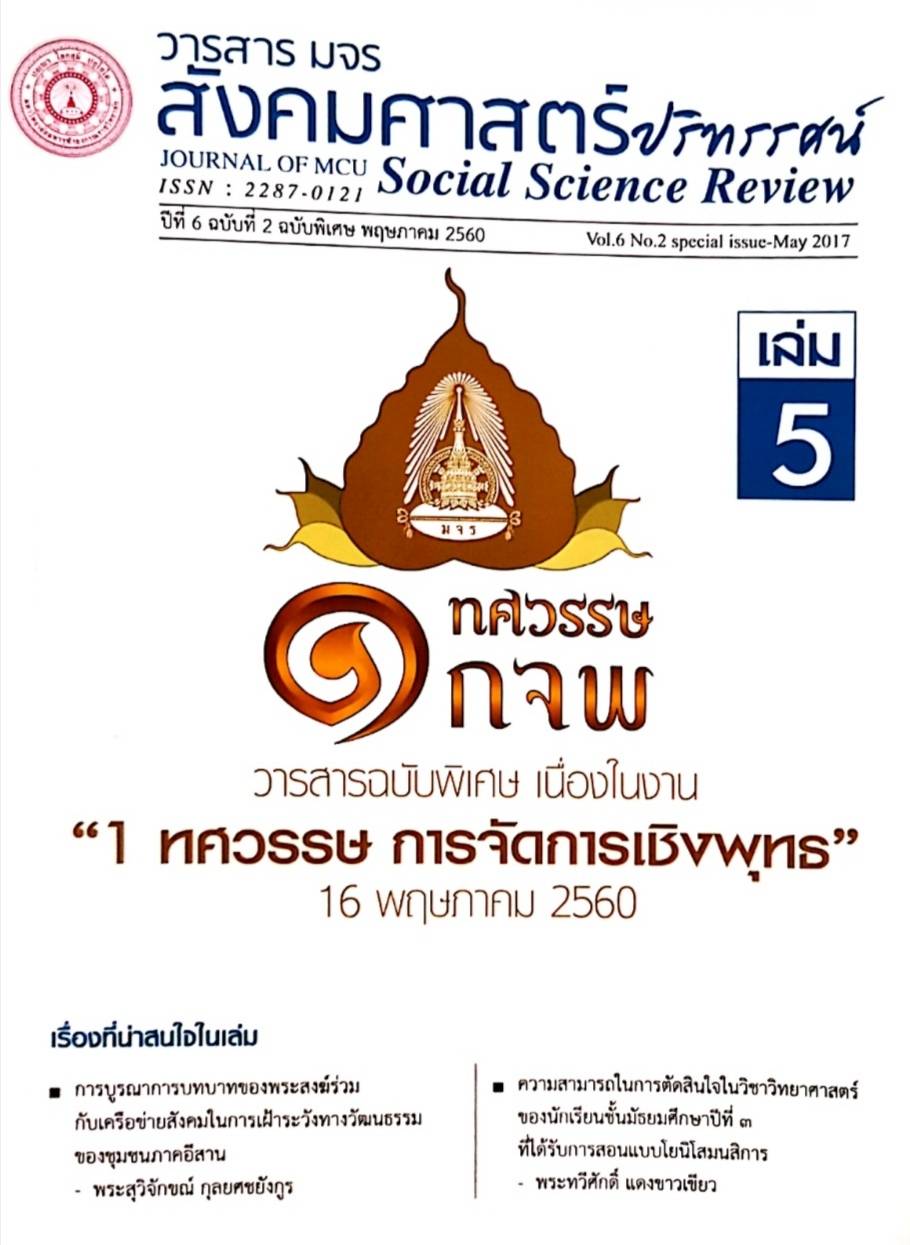การพัฒนารูปแบบการใช้พื้นที่วัดเชิงพาณิชย์แนวบุญนิยมในภาคอีสาน
คำสำคัญ:
การใช้พื้นที่วัดเชิงพาณิชย์, บุญนิยมบทคัดย่อ
บทความวิจัยนี้มีวัตถุประสงค์ คือ 1) เพื่อศึกษาประวัติความเป็นมาของการใช้พื้นที่วัด เชิงพานิชย์ 2) เพื่อศึกษาสภาพปัจจุบันและปัญหาการใช้พื้นที่วัดเชิงพาเนิชย์ในภาคอีสาน และ 5) เพื่อการพัฒนารูปแบบการใช้พื้นที่วัดเชิงพาณิชย์แนวบุญนิยมในภาคอีสาน เครื่องมือที่ใช้ ได้แก่ แบบสํารวจ แบบสังเกตและแบบสัมภาษณ์ เก็บรวบรวมข้อมูลจากผู้ให้ข้อมูลจํานวน 72 คน โดยวิธีการสํารวจ การสังเกตและการสัมภาษณ์ วิเคราะห์ข้อมูลตามลําดับความมุ่งหมาย เสนอ ผลการวิจัยโดยวิธีพรรณนาวิเคราะห์
ผลการวิจัยพบว่า
ประวัติความเป็นมาของการใช้พื้นที่วัดเชิงพาณิชย์ (มูลค่า) พบว่า ประวัติความเป็นมา ของการใช้พื้นที่วัดในอดีตเริ่มจากการก้าเป็นระบบศักดินาทั่วไป ถ้าเป็นระบบศักดินาในประเทศไทย พระราชบัญญัติคณะสงฆ์จากอดีตถึงปัจจุบัน ได้แก่ กฎหมายสงฆ์สมัยรัชกาลที่ 1 (2325) พระราช บัญญัติ ลักษณะปกครองคณะสงฆ์ ร.ศ. 121 (2445) พระราชบัญญัติคณะสงฆ์ พุทธศักราช 2484 การใช้พื้นที่ธรณีสงฆ์พระราชบัญญัติคสนะสงฆ์ 2505 การใช้พื้นที่ธรเนีสงฆ์พระราชบัญญัติคณะสงฆ์ พ.ศ. 2505 ฉบับแก้ไขปรับปรุง พ.ศ. 2535 และพระราชบัญญัติคณะสงฆ์ที่ชี้เฉพาะการจัดการบน พื้นที่วัดตามกฎระเบียบมหาเถรสมาคม ประวัติความเป็นมาและการใช้พื้นที่วัด ทั้ง 6 วัด ได้แก่ วัดบึง วัดสะแก วัดปทุมชาติ วัดชัยสามหมด วัดกลาง และวัดทักษิณาวาส ในการใช้เขตพื้นที่วัดที่เป็นเขต พุทธาวาส เขตสังฆาวาส และเขตพื้นที่จัดผลประโยชน์
สภาพปัจจุบันและปัญหาการใช้พื้นที่วัดเชิงพาณิชย์ในภาคอีสาน พบว่า มีการใช้พื้นที่ธรณี สงฆ์ 5 ประสาท ได้แก่ ตึกแถวให้เช่า พื้นที่ให้เช่า ลานจอดรถ มาปนสยาน และโรงเรียนในสนาพ การ บริหารจัดการพื้นที่วัด 8 ประเด็น ได้แก่ ด้านบุคคล เครื่องมือเครื่องใช้ ด้านทุน ด้านสิ่งแวดล้อม ด้านกฎ กติกา มารยาพ ล้านไรีการขั้นตอน ด้านผลงาน และด้านอุปสรรค ปัญหา ส่วนปัญหาการใช้ พื้นที่วัด พบว่า ศึกแถวให้เช่า คือ เอกชนเช่าในราคาที่ต่ํากว่าท้องตลอดทั่วไป เช่าแล้วนําไปให้บุคคล อื่นเช่าต่ออีกที่หนึ่งลานจอดรถ คือ ผู้ที่เข้ามาจอดรถไม่ยอมจ่ายค่าใช้บริการ เนื่องจากอ้างเหตุผลว่า ใช้เวลาจอดไม่นาน มาปนสถาน คือ รัดที่อยู่ในเมืองมีพื้นที่ไม่เพียงพอในการให้บริการแขกที่มา ร่วมงาน ส่วนโรงเรียน คือ การจัดกิจกรรมการเรียนการสอนไม่เข้มข้นเหมือนเหมือนโรงเรียนทั่วไป
การพัฒนารูปแบบการใช้พื้นที่วัดเชิงพาณิชย์แนวบุญนิยมในภาคอีสาน พบว่า การใช้ พื้นที่วัดทั้ง 5 ประเภท จะต้องเน้นในเรื่องของบุญนิยม ต้านทาน ศีล และภาวนา เข้ามาใช้ในการ บริหารจัดการพื้นที่จัดผลประโยชน์ในเชิงพาณิชย์ (มูลค่า) และเชิงคุณภาพชีวิต (คุณค่า) ให้มากที่สุด โดยมุ่งหวังเอาผลบุญ หรือผลที่เกิดด้านสภาพจิตใจเป็นที่ตั้ง มีการพึ่งพาอาศัยกันระหว่างวัดกับผู้ที่ เข้ามาใช้พื้นที่วัด
โดยสรุป การพัฒนารูปแบบการใช้พื้นที่วัดเชิงพาณิชย์แนวบุญ นิยมในภาคอีสานในการบริหารจัดการตึกแถวให้เช่า พื้นที่ให้เช่า ลานจอดรถ ฌาปนสถาน และ โรงเรียน ยึดหลักอยู่การใช้ประโยชน์เชิงพาณิชย์ (มูลค่า) และ การใช้ประโยชน์เชิงคุณภาพชีวิต (คุณค่า) ซึ่งจะเห็นว่าการใช้ประโยชน์เชิงคุณภาพชีวิตเกิดบุญนิยมด้านทาน ศีล และภาวนา มากกว่า การใช้ประโยชน์เชิงพาณิชย์
เอกสารอ้างอิง
พระเทพเวที (ประยุทธ์ ปยุตโต). (2545). พุทธศาสนาในฐานะเป็นรากฐานของวิทยาศาสตร์กรุงเทพฯ : มูลนิธิพุทธธรรม.
พระมหารัตนะ รตนสร. (2559). “ผ้าไตรจีวร : การศึกษาภูมิปัญญาความเชื่อและการผลิตเพื่อเศรษฐกิจชุมชนแบบบุญนิยม กรุงเทพมหานครและปริมณฑล” วิทยานิพนธ์ปรัชญาดุษฎีบัณฑิต มหาวิทยาลัยมหาสารคาม.
พระมหาเรื่องเดช ศรีประสม (ถาวรธมโม), (2553). “ศูนย์การเรียนรู้: การพัฒนารูปแบบเพื่อบริการชุมชน ของวัดในภาคตะวันออก” วิทยานิพนธ์ปรัชญาดุษฎีบัณฑิต มหาวิทยาลัยมหาสารคาม
พระมหาสุนันท์ สุมนโท (รุจิเวทย์). (2558), “การพัฒนารูปแบบการจัดการศาสนสมบัติของวัดใน จังหวัด พระนครศรีอยุธยา" วิทยานิพนธ์พุทธศาสตรดุษฎีบัณฑิต มหาวิทยาลัยมหาจุฬาลงกรณราชวิทยาลัย
พระมหาอุทัย ไชยะพันธ์. (2551). การศึกษาแนวทางการอนุรักษ์และพัฒนากระบวนการจัดการบุญ สังฆทานโดยการมีส่วนร่วมของชุมชนจังหวัดศรีสะเกษ, ปริญญาศิลปศาสตรมหาบัณฑิต สถาบันวิจัยศิลปะและวัฒนธรรมอีสาน มหาวิทยาลัยมหาสารคาม.
ดาวน์โหลด
เผยแพร่แล้ว
รูปแบบการอ้างอิง
ฉบับ
ประเภทบทความ
สัญญาอนุญาต
ลิขสิทธิ์ (c) 2020 วารสาร มจร สังคมศาสตร์ปริทรรศน์

อนุญาตภายใต้เงื่อนไข Creative Commons Attribution-NonCommercial-NoDerivatives 4.0 International License.
เพื่อให้เป็นไปตามกฎหมายลิขสิทธิ์ ผู้นิพนธ์ทุกท่านต้องลงลายมือชื่อในแบบฟอร์มใบมอบลิขสิทธิ์บทความให้แก่วารสารฯ พร้อมกับบทความต้นฉบับที่ได้แก้ไขครั้งสุดท้าย นอกจากนี้ ผู้นิพนธ์ทุกท่านต้องยืนยันว่าบทความต้นฉบับที่ส่งมาตีพิมพ์นั้น ได้ส่งมาตีพิมพ์เฉพาะในวารสาร มจร สังคมศาสตร์ปริทรรศน์ เพียงแห่งเดียวเท่านั้น หากมีการใช้ภาพหรือตารางหรือเนื้อหาอื่นๆ ของผู้นิพนธ์อื่นที่ปรากฏในสิ่งตีพิมพ์อื่นมาแล้ว ผู้นิพนธ์ต้องขออนุญาตเจ้าของลิขสิทธิ์ก่อน พร้อมทั้งแสดงหนังสือที่ได้รับการยินยอมต่อบรรณาธิการ ก่อนที่บทความจะได้รับการตีพิมพ์ หากไม่เป็นไปตามข้อกำหนดเบื้องต้น ทางวารสารจะถอดบทความของท่านออกโดยไม่มีข้อยกเว้นใดๆ ทั้งสิ้น





